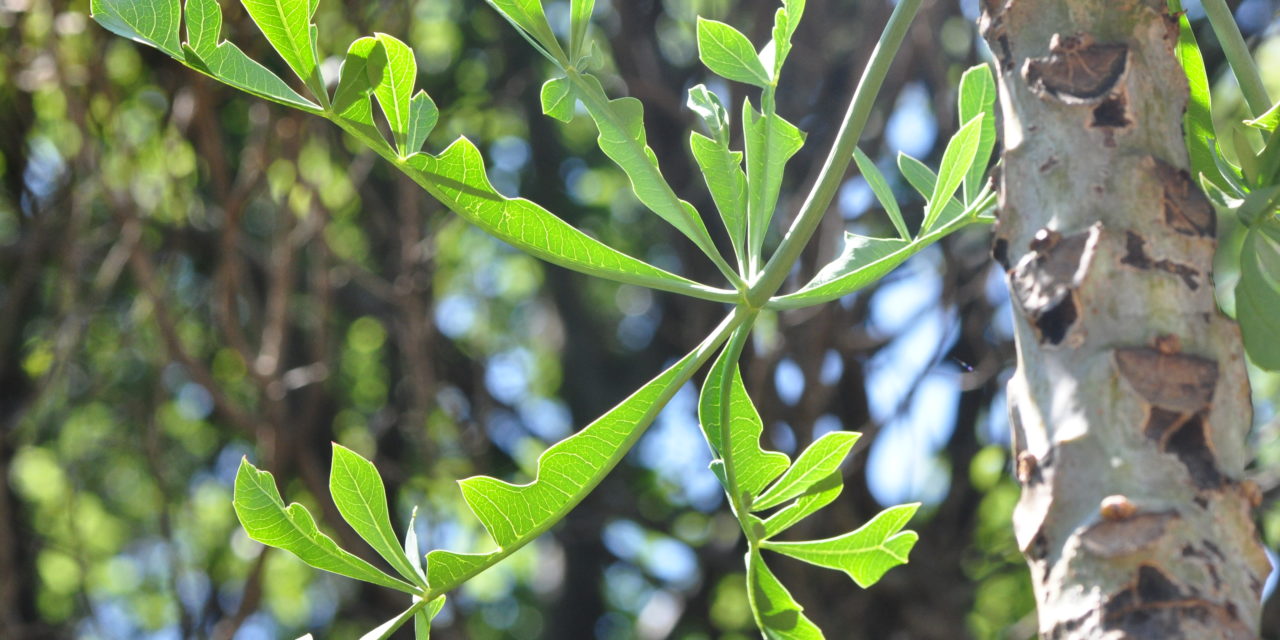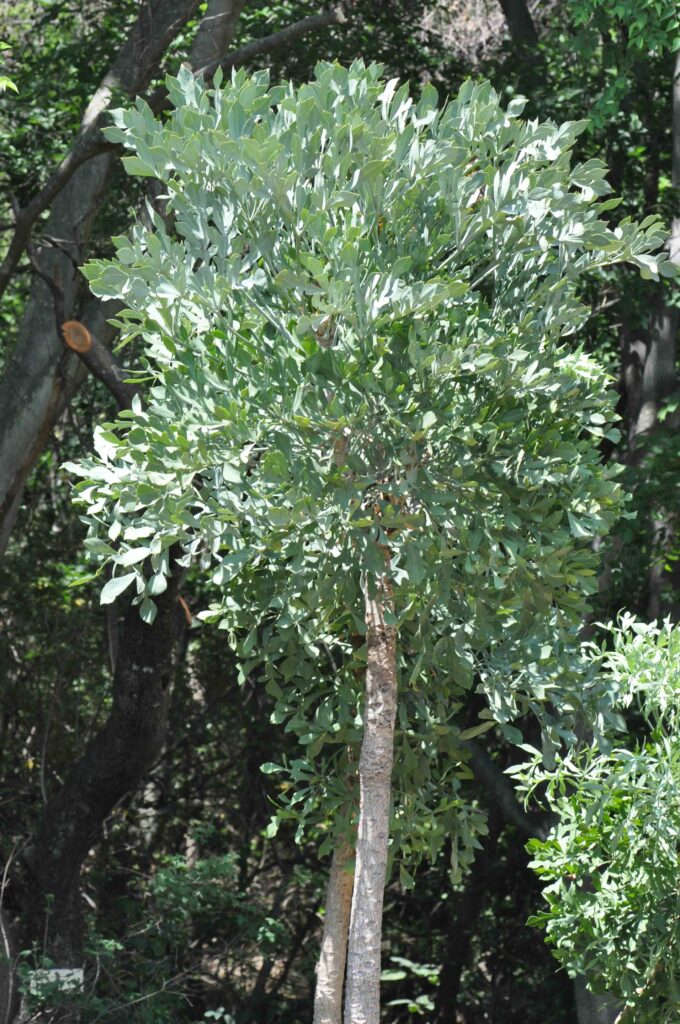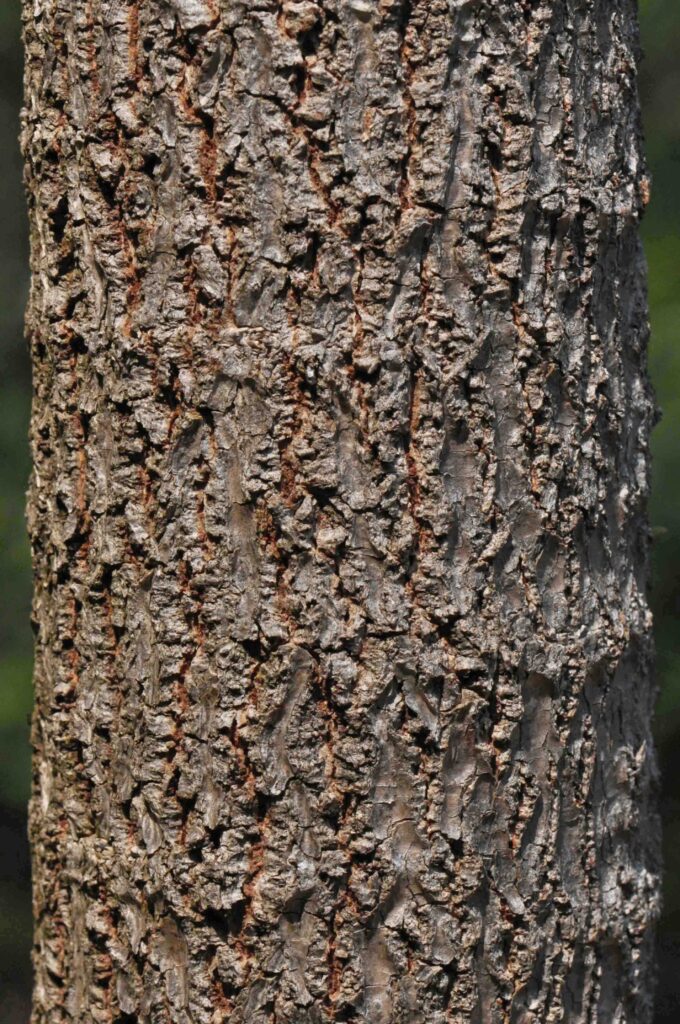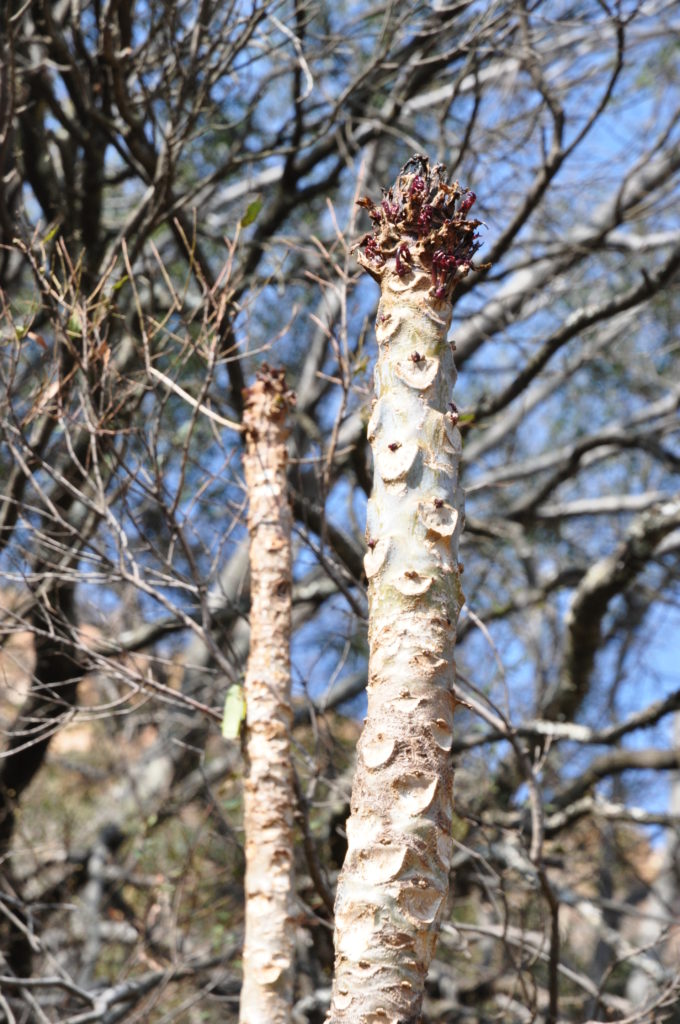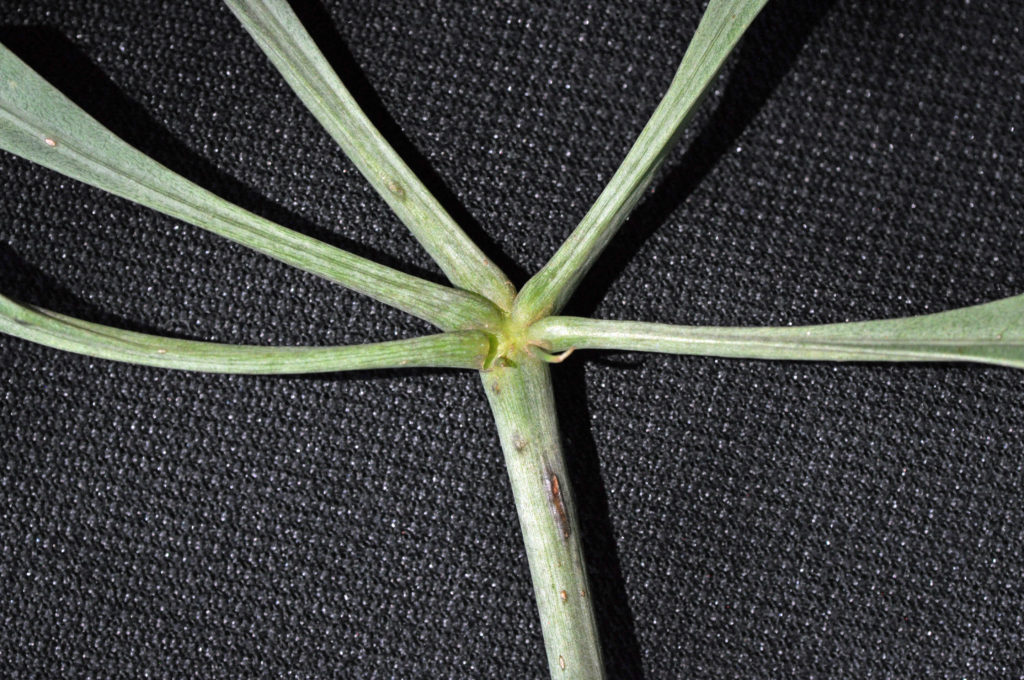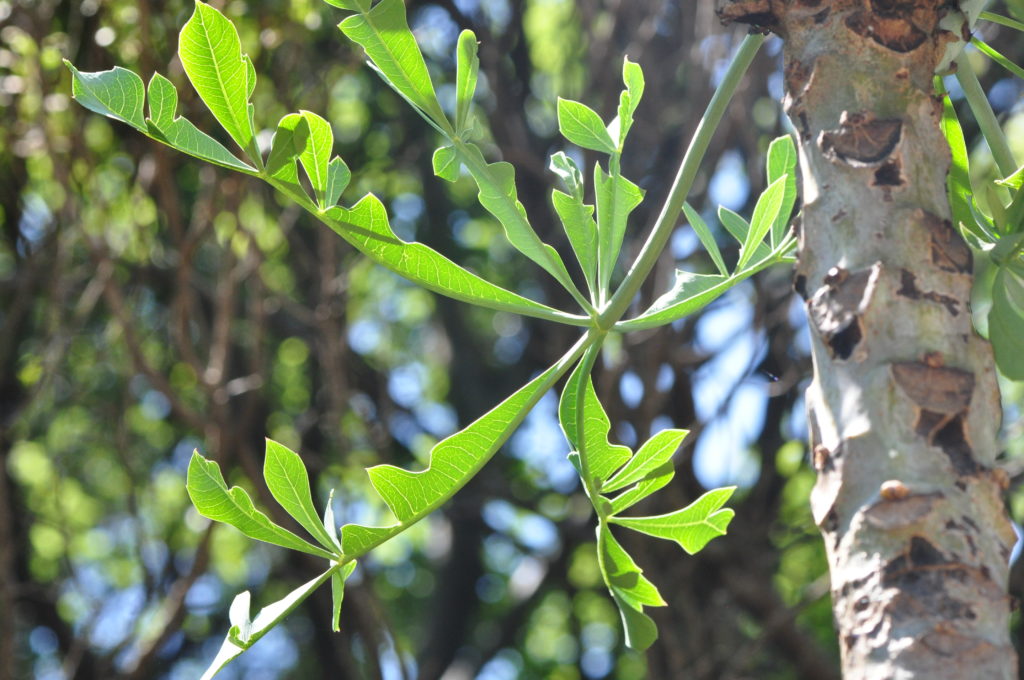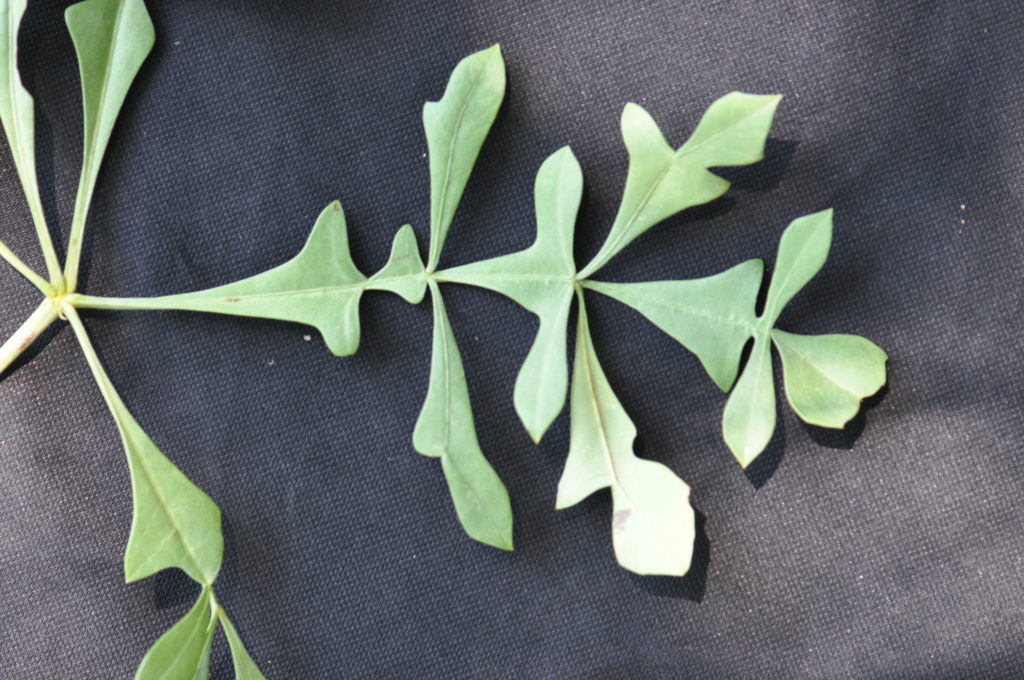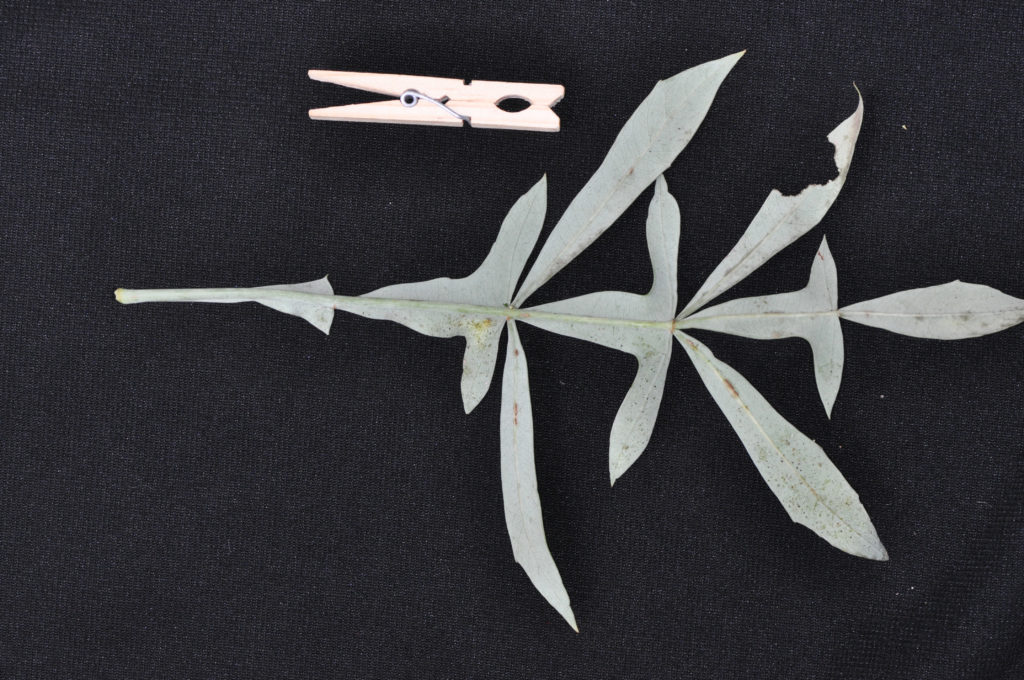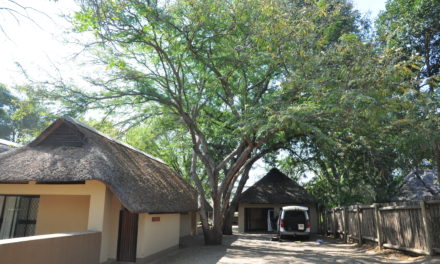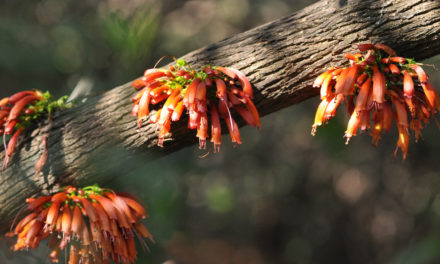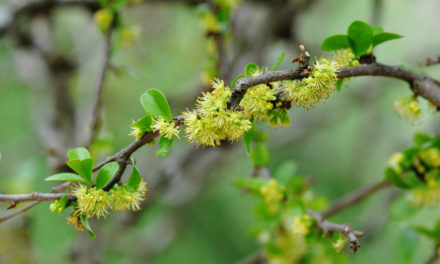Cussonia transvaalensis
General Info – summary
This usually evergreen, single stemmed, sparsely branched Tree is up to 5m high. Bark is corky and rough. The grey trunk has visible leaf scars. The bipinnate and stipulate Leaves have long petioles, noticeable petiolules that end with 7 to 9 leaflets. Small 5-merous, actinomorphic and bisexual Flowers are in closely packed spikes. Fruits are small fleshy, conical, purple drupes – crowded along each spike.
Description
SA Tree No. 564.3. (New species described in 1984).
Common names: (Afr) Transvaalkiepersol, Vaalkiepersol. (Eng) Grey Cabbage tree, Silver Cabbage-tree, Transvaal Cabbage Tree. (Northern Sotho) Motshetshe.
Family Araliaceae: (Ivy and cabbage-tree family). The family includes trees, shrubs, vines and herbs. The mainly woody species are of tropical distribution. In southern Africa, there are 5 genera and about 18 species. Those genera with trees on this website include Cussonia and Schefflera. Leaves are usually alternate. They may also be once or twice digitally compound. 1-3 bracts that persist around the fruit, subtend the regular, bisexual or unisexual Flowers. In Cussonia the flowers are in spikes or racemes and in Schefflera flowers are umbels, in panicles. The Calyx is often reduced. There are usually as many Stamens as Petals. Anthers are ovate or oblong with 2 pollen sacs. The usually 5 petals are attached to the inferior, 2-locular Ovary. Each locule has a single ovule. Styles equal the number of locules. The often-fleshy Fruit is usually a drupe or berry. It may split into individual carpel units, called mericarps, with 1 or more seeds.
Name derivation: The name Cussonia was given by Carl Peter Thunberg to commemorate the French botanist Pierre Cusson (1727-1783). He was professor of Botany at the University of Montpellier in France. He specialised in the Apiaceae or Umbellifera. transvaalensis – referring to the former province – the old Transvaal – where the plant was first fond. There are about 25 species of the genus Cussonia. About 10 of these occur in the southern Africa.
Conservation: National Status: L C. (Least Concern). Assessed: 2005 (W. Foden and L. Potter).
Tree
The sturdy, usually single stemmed Tree and its sparsely branched crown, are up to 5m high (photo 882). The Bark on the trunk is grey rough and corky, (photo 298), with horizontal furrows (photo 299) and deeply longitudinally fissured. Leaf scars are clearly visible closer to the apex of the stem after leaves fall from this deciduous tree (photo 299). Lower branches also fall – leaving hollow branches after falling (photo 30).
- 882. 2015/09/29. Walter Sisulu NBG. Photo: David Becking.
- 298. 2015/10/13. Walter Sisulu NBG. Photo: David Becking.
- 299. 2015/10/13. Walter Sisulu NBG. Photo David Becking.
- 30. 2014/08/19. Walter Sisulu NBG. Photo David Becking.
Leaves
This usually evergreen tree has leathery, light blue to grey-green Leaves that are concentrated in rosettes at branch ends. Leaves are glabrous (hairless), bipinnate (compound: twice pinnate) with 7 to 9 Leaflets. The first division of this palmately compound leaf arises from a single point at the end of the stout (60-100cm long) Petiole (leaf stalk: photos 886 & 948). The Petiolules (leaflet stalks) of the primary leaflets are up to 9cm long. From the end of the petiole (photo 886), arise the midribs (the main rib of a leaf or leaf-like part, a continuation of the petiole) on which the leaflets can be seen (photo 885). After the first division, the margins of the lobes are so deeply divided that they reach the midrib creating the Leaflets – Pinnules (the final free division of a pinnately compound leaf). Here 5 or more leaflets develop (photo 765). The hairless, leathery Margin is deeply cut to the midrib. The Apex and Base both taper. Stipules (basal appendage of the petiole) are present.
- 886. 2015/09/29. Walter Sisulu NBG. Photo: David Becking.
- 948. 2014/11/25. Walter Sisulu NBG. Photo: David Becking.
- 885. 2015/09/29. Walter Sisulu NBG. Photo: David Becking.
- 765. 2016/05/10. Walter Sisulu NBG. Photo David Becking.
Flowers
The terminal, bisexual, greenish-yellow and stalkless Flowers are 5-merous (have floral parts in 5’s). They are actinomorphic (Regular, symmetrical. Flowers are vertically divisible into similar halves by more than 1 plane passing through the axis). A single Bract (a much-reduced specialised leaf, particularly the small scale like leaves in a flower cluster or associated with flowers) subtends them. Flowers are arranged in terminal double umbels (umbel – inflorescence in which flower stalks arise from a common point) with 7 to 11 thick, closely packed unbranched Spikes (a spike is a simple indeterminate inflorescence with sessile flowers on a single Peduncle – stalk of flower cluster). Each peduncle is up to 6cm long. These spikes are 11-15cm long and up to 3cm wide. The spikes collectively form a candelabra-like head. There are 5 Sepals in the Calyx, and the 5 Petals are valvate (edges meet without overlapping). There are 5 Stamens, and their ovate Anthers have 2 Theca (pollen sacs). There is a single Pistil (a unit of the Gynoecium, the female element of the flower, composed of the Ovary, Style and Stigma). The inferior, 2-chambered Ovary has 2 Styles.
Fruit
The small, fleshy, conical Fruit is an initially green Drupe (a fleshy, 1-seeded indehiscent fruit with the seed enclosed in a stony endocarp; stone fruit e.g., peach). The mature fruit turns purple and is edible. It is about 1cm long and almost spherical or oblong. Individual fruit lack a stalk and are collectively crowded along each spike.
Distribution & Ecology
This Tree occurs in North-West, Gauteng, Mpumalanga and Limpopo (Waterberg). Trees can survive mild frost. They grow in the bushveld (a sub-tropical woodland ecoregion of southern Africa) in hot, dry wooded grassland and rocky slopes in sandstone and quartzite (rock composed almost entirely of quartz. It is non-foliated and usually forms from the metamorphosis of sandstone). Birds relishes the Fruit. The trees are insect Pollinated, having bee and fly attracting nectar that possesses an unpleasant smell (for us). This makes an interesting garden plant and will also grow in a container.
Ethnobotany
The succulent Roots are edible and are a useful source of liquid in dry times. The Wood is soft and used for carving and fuel. Thin plant is suitable for Bonsai. Fresh Seeds should have the fleshy part of the drupe removed in water before planting. They respond well to fertilizer. Once established this plant does not transplant well. This plant survives in dry areas. Note: the Roots can be invasive. Keep plants away from sewerage, water lines and buildings – including pools. Sap sucking insects may disfigure this and a number of other plants. Only use pesticides if they become a major problem.
References
Coates Palgrave, M. 2002. Keith Coates Palgrave Trees of Southern Africa. edn 3. Struik, Cape Town.
Foden, W. & Potter, L. 2005. Cussonia transvaalensis Reyneke. National Assessment: Red List of South African Plants version . Accessed on 2024/08/22.
Lawrence, G. H. M, 1951. Taxonomy of Vascular Plants. The Macmillan Company, New York. Tenth Printing 1965.
Schmidt, S. Lotter, M. & McCleland, W. 2002. Trees and Shrubs of Mpumalanga and the Kruger National Park. Jacana, Johannesburg.
van Wyk, B. & van Wyk, P. 1997 Field guide to Trees of Southern Africa. Struik, Cape Town.
http://www.plantzafrica.com/plantcd/cussontrans.htm
http://posa.sanbi.org/flora/browse.php?src=SP

